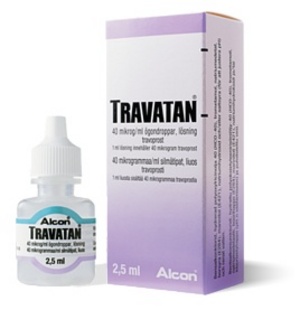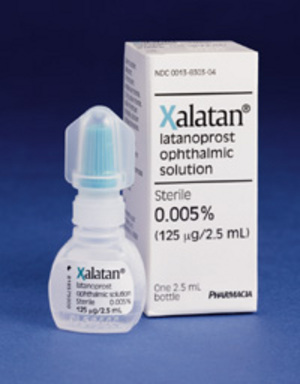If you are a patient with elevated intraocular pressure with open-angle glaucoma or if you have ocular hypertension and are intolerant of other intraocular pressure lowering agents, or if you have been insufficiently responsive to another intraocular pressure lowering agent, Travatan is for you.
Travatan is also known as Travoprost. Travatan comes in an ophthalmic solution which is ).004% in strength. It is available in 2.5 mL and 5 mL bottles.
The recommended dose is one drop in the affected eye or eyes once daily in the evening. If you use Travatan more than the recommended dose, this will cause a decrease in the intraocular lowering effect. To instill Travatan in your eye, make sure to wash your hands thoroughly. Lie down or tilt head backward and look up at the ceiling. Hold the dropper right above your eye, and drop the solutions inside the lower lid. Make sure the dropper does not come in contact with you eye to avoid infection. Before instilling other ophthalmic solutions in your eyes, wait five minutes in between. Try not to squint or close your eyes tightly after administering Travatan to help Travatan penetrate your eye and increase the pressure-lowering effects. Do not use Travatan while wearing contact lenses, and only remove them after fifteen minutes of the Travatan instillation.
The Travoprost in Travatan is a manmade prostaglandin F analog which mimics the body’s prostanoid receptors. This act increases aqueous fluid outflow. Travoprost acts locally without much systemic action.
Travatan may permanently change the color or the iris of the eye, especially if you have hazel eyes, or any other light colored eyes. This change is irreversible. The growth of your eyelashes may experience faster growth, and your eyelid may also slightly change pigmentation. If you’re a patient with active intraocular inflammation, or happen to be an aphakic, pseudophakic patient with a torn posterior lens capsule, or if you’re at a risk for macular edema, use Travatan with extreme caution. Rare cases of macular edema have been reported while using Travatan.
The most common side effect is ocular hyperemia (excessive reddening of the conjunctiva.) Other side effects reported include blurred vision, eye discomfort, a feeling of something in your eye, pain, dry eye, lid margin crusting, sensitivity to light, and pruritis (itching sensation in the eye).
Do not discontinue Travatan without first talking to your doctor. If you have any Travatan left over, dispose of it. Store Travatan in a cool, dry place away from children and sunlight. If you miss a dose of Travatan, instill it as soon as possible, unless the time is closer to your next dose. If there are side effects with are impairing and very severe, contact your physician immediately.
With regular use and proper technique, Travatan can prove to be a wonderful aid in reducing intraocular pressure, and thus letting you carry on with your life in an ocular pain-free manner.





